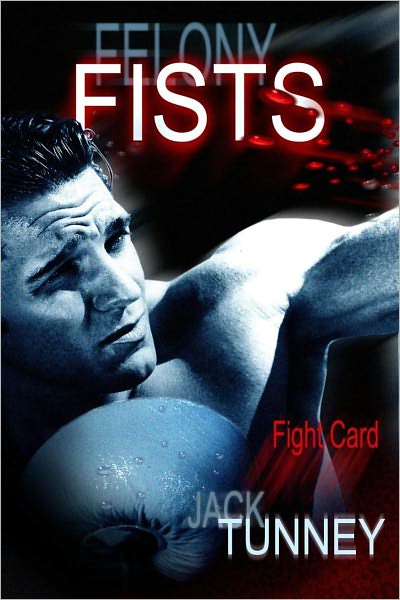
So far as I know, it's been quite a while since fiction like this has been available, and I'm pretty stoked that it's making a comeback.
Felony Fists is an installment in the new pulp Fight Card series by "Jack Tunney." For you armchair fight historians out there, that nome de plume is exactly what you suspect it is--a fusion between Jack Dempsey and Gene Tunney, though the series takes place in the '50s, not the '20s.
Patrick "Felony" Flynn is an LA beat cop who is also possibly the world's most seasoned amateur middleweight. He's offered a spot on the detective squad if he'll help knock gangster Mickey Cohen out of boxing. That means he has to move up in weight to light-heavy, turn pro, and check Cohen's fighter Solomon King's ascent toward a title shot against Archie Moore (who really was light-heavyweight champ at that time, and quite an extraordinary man). A middleweight moving up to fight a badass light-heavyweight is a monumental chore all by itself, but in case the reader doesn't appreciate that, the pressure is heaped upon Felony Flynn increasingly right up until the last chapter.
During all this time, Flynn becomes partners with another rookie detective, Tombstone. A black detective on an historically/notoriously bigoted force like the LAPD must be exceptional, and Tombstone is. This subplot, a counterfeiting subplot, and the fight plot all come together and are tied off nicely. The writer set out to tell a retro-style pulp boxing yarn and I'd say he did a good job.
For my taste, Cohen's tactic to get Flynn to throw the fight was overkill. The stakes were plenty high already, as were the odds against Flynn in the fight. For Cohen to be so scared of an Irish brawler with one professional fight (against an over-rated has-been) presenting a threat to a contender who consumes talented pros for breakfast (and who Archie Moore is worried about) was just too much. In Flynn's other fights, he never was 100% on. He was either distracted, or careless...something to put the outcome in doubt. I really would have liked to see Flynn go to war from Round One in the climactic fight, and let the tension come from the fact that he's overmatched, and making it through 15 rounds with Solomon King requires a superhuman effort. Plenty of tension that way and far more realistic.
Speaking of realism, I just have to provide the following advisory about boxing technicalities:
In boxing, a right-handed fighter does not have a right jab or a right hook. He jabs and hooks with the left. He throws straight rights or a right cross. (Everything I'm saying is mirror-opposite for a southpaw, of course.) What some people call a right hook from a right-hander is actually either an angled right uppercut or a roundhouse right--an ill-advised punch 99% of the time, though I did see Lennox Lewis score a knockout with one.
I don't know how many other readers would notice or care about getting these fundamental details right, but for me it was an annoyance in what otherwise was an enjoyable read. And to be fair, a LOT of authors who write about boxing make these kind of mistakes. Even legendary writers like Robert E. Howard didn't always get everything right.
At the back of this book are sneak previews of two other tales from the Fight Card series. In The Cut Man, the author confuses the 1st Marine Division ("The Old Breed") with the 1st Infantry Division ("The Big Red One"). That made me grind my teeth, and I know any marine or grunt who reads it will have problems with it, too. I hope the author will correct this (edits are easy and painless for e-books), because details like this can really ruin a story for some readers.

Thx for this insightful review. Your critiques are appreciated and noted, as are your overall positive comments...
ReplyDelete'Twas a pleasure, Bish. This is a great series, and off to a great start.
ReplyDelete